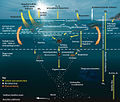Mediterranean Sea (strain MED). The name Prochlorococcus originated from the fact it was originally assumed that Prochlorococcus was related to Prochloron and other...
37 KB (3,719 words) - 16:34, 4 June 2024
The smallest of all, Prochlorococcus, is just 0.5 to 0.8 micrometres across. In terms of numbers of individuals, Prochlorococcus is possibly the most...
179 KB (17,664 words) - 20:32, 24 August 2024
Constants, Units, and Uncertainty. NIST. Retrieved 23 August 2011. "Prochlorococcus marinus MIT 9313 - Home". Joint Genome Institute. Archived from the...
79 KB (4,550 words) - 13:37, 20 August 2024
article by A.V. Pinevich ). In 1986 Prochlorococcus was found by Sallie W. (Penny) Chisholm and colleagues. Prochlorococcus may be responsible for a significant...
5 KB (505 words) - 00:13, 19 May 2024
Cyanobacteria belonging to the genus Prochlorococcus are particularly remarkable. With a typical size of 0.6 μm, Prochlorococcus was discovered only in 1988 by...
20 KB (2,404 words) - 22:08, 18 May 2024
as the phytoplankton of the oceans. The tiny marine cyanobacterium Prochlorococcus was discovered in 1986 and accounts for up to half of the photosynthesis...
16 KB (1,539 words) - 03:45, 23 August 2024
viral particles.[citation needed] Certain cyanophages infect and burst Prochlorococcus, the world's smallest and most abundant primary producers. Marine cyanophages...
36 KB (4,106 words) - 08:12, 19 August 2024
Streamlining theory (section Prochlorococcus)
Two of the free-living bacterial taxa with the smallest genomes are Prochlorococcus and Pelagibacter ubique, both highly abundant marine bacteria commonly...
22 KB (2,559 words) - 09:42, 22 June 2024
hydrogen peroxide by helper microbes: the impacts on the cyanobacterium Prochlorococcus and other beneficiaries in marine communities". Environmental Microbiology...
143 KB (15,531 words) - 19:34, 31 July 2024
Chain P, Ahlgren NA, et al. (August 2003). "Genome divergence in two Prochlorococcus ecotypes reflects oceanic niche differentiation". Nature. 424 (6952):...
80 KB (7,347 words) - 15:48, 17 August 2024
The smallest of all, Prochlorococcus, is just 0.5 to 0.8 micrometres across. In terms of individual numbers, Prochlorococcus is possibly the most plentiful...
46 KB (4,207 words) - 22:04, 23 May 2024
Swallow's work on the Swallow float in the late 1950s, the discovery of Prochlorococcus by a team of researchers in the 1980s, and various oceanographic data...
24 KB (2,585 words) - 21:15, 3 August 2024
to the chlorophyll structures are known in the wild. For example, Prochlorococcus, a cyanobacterium, uses 8-vinyl Chl a and b. Chlorophylls can be extracted...
35 KB (3,529 words) - 15:32, 25 July 2024
allowed marine researchers to distinguish between dimly-fluorescing Prochlorococcus and heterotrophic microorganisms, a distinction that is difficult with...
60 KB (6,904 words) - 04:27, 28 July 2024
plays a major role in global carbon cycles The tiny cyanobacterium Prochlorococcus is a major contributor to atmospheric oxygen The sea sparkle dinoflagellate...
62 KB (6,472 words) - 17:16, 3 August 2024
diagnostic pigment for this organism is known. Zeaxanthin is also found in Prochlorococcus, red algae and as a minor pigment in some chlorophytes and eustigmatophytes...
30 KB (3,294 words) - 05:56, 12 August 2024
all of the sources of photosynthesis: for example the cyanobacterium Prochlorococcus—which accounts for more than half of marine photosynthesis—was not...
97 KB (10,809 words) - 05:16, 17 August 2024
photosynthetic plastids Paulinella amoeboids of the cyanobacteria genera Prochlorococcus and Synechococcus, or the "PS-clade". Secondary and tertiary endosymbiosis...
28 KB (3,217 words) - 23:48, 24 August 2024
systems Williamson and her team focused on during this research was the Prochlorococcus marinus. This group of cyanobacteria are the most abundant photosynthetic...
15 KB (1,495 words) - 08:43, 29 May 2024
A myovirus which infects cyanobacterium Prochlorococcus....
23 KB (2,553 words) - 21:49, 9 February 2024
There are a few notable and well-known exceptions that include most Prochlorococcus and some Synechococcus that can only take up nitrogen as ammonium....
57 KB (6,235 words) - 12:52, 19 August 2024
and "it probably really is the commonest organism on the planet". Prochlorococcus Synechococcus Smallest organisms Oren A. (2017). "A plea for linguistic...
19 KB (1,930 words) - 09:43, 22 June 2024
these cyanobacteria come from the marine environment. These are six Prochlorococcus strains, seven marine Synechococcus strains, Trichodesmium erythraeum...
78 KB (7,545 words) - 14:27, 4 August 2024
pan-genome is Prochlorococcus, the core genome set is much smaller than the pangenome, which is used by different ecotypes of Prochlorococcus. Open pan-genome...
50 KB (5,342 words) - 00:14, 15 August 2024
The smallest of all, Prochlorococcus, is just 0.5 to 0.8 micrometres across. In terms of individual numbers, Prochlorococcus is possibly the most plentiful...
158 KB (16,553 words) - 06:38, 16 August 2024
producers of the Earth’s oxygenic atmosphere. The marine cyanobacteria Prochlorococcus and Synechococcus appear to have an E. coli like SOS system for repair...
13 KB (1,497 words) - 02:17, 30 July 2024
picoflagellates and nanoflagellates), mostly composed of cyanobacteria (Prochlorococcus, Synechococcus) and picoeucaryotes such as Micromonas. Within more...
63 KB (6,481 words) - 06:01, 10 July 2024
research focuses particularly on the most abundant marine phytoplankton, Prochlorococcus, that she discovered in the 1980s with Rob Olson and other collaborators...
13 KB (1,126 words) - 22:05, 16 July 2024
with the requirements of two specific cyanobacteria: Prochlorococcus and Synechococcus. Prochlorococcus is the dominant species of picophytoplankton within...
69 KB (8,208 words) - 02:23, 23 August 2024
modulate both microbial population size and diversity. The cyanobacterium Prochlorococcus, the most abundant oxygenic phototroph on Earth, contributes a substantial...
88 KB (9,234 words) - 19:15, 14 June 2024



























